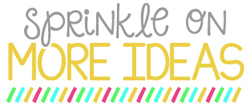If you're a Texas teacher, I'm sure you've heard about Figure 19 in our state standards. If you aren't from Texas - Figure 19 is our metacognitive reading skills in both assigned and independent reading to understand an author’s message. It's like an amendment to our Language Arts standards (TEKS) to help students read more complex texts as they become self-directed, critical readers.
The standards stated in Figure 19 are:
*discuss the purposes for reading and listening to various texts (e.g., to become involved in real and imagined events, settings, actions, and to enjoy language)
*ask and respond to questions about text
*monitor and adjust comprehension (e.g., using background knowledge, creating sensory images, rereading a portion aloud)
*make inferences based on the cover, title, illustrations, and plot
*retell or act out important events in stories
*make connections to own experiences, to ideas in other texts, and to the larger community and discuss textual evidence
This can seem intimidating in our kinder land of fun. Sometimes reading these standards can make my skin prickle like a hedgehog.
But I have also seen my littles accomplish these standards with some different strategies I introduced to them. THEY CAN DO ANYTHING! I truly believe this.
I wanted to break down each standard and show some strategies and share some freebies to make these standards teachable in (hopefully) engaging ways for your littles. One element of learning that helped us was my four comprehension Beanie Babies.
These 4 babies really helped my babies. I even have puppets of them for our whole group area to help with their different areas of comprehension. (Rocky the Raccoon was absent the day I took this pic.)
These puppets stay at my easel all day, but my littles always have permission to play with them in the puppet stand at the end of the day for social learning. They take such great care of them and even use them to ask each comprehension questions. Who says play isn't learning?!?
I also have them located at my guided reading table. They're attached with velcro so I can change the board for each groups' needs.
You can get this set for $3 in my shop. Now onto breaking down each standard...
Discuss the purposes for reading and listening to various texts (e.g., to become involved in real and imagined events, settings, actions, and to enjoy language): This standard can be mastered simply by reading a daily poem! It's so fun to read poetry with young students. Jack Prelutsky is my ALL TIME favorite poet for young children. Poetry accomplishes so much learning and provides great discussion for young children. After I read a poem, I have kiddos turn to their floor friend and discuss how the poem made them feel, why they did or didn't like the poem, and would you like to live in the setting of the poem - why or why not? Kindergarteners love to respond to poems because it's just their opinions and we all know that Kinder kids can talk and talk and talk...

Ask and respond to questions about text: Questioning Owl is introduced and used with this standard. We learn that good readers ask questions before, during, and after reading. My cuties love that they can ask questions all throughout the book to gain a better understanding. I use this chart often when we are learning about asking questions.
My kiddos just love when Questioning Owl flies out to ask us to ask questions. Often the questions that are asked before reading reflect the cover and the title of the book, which is another standard - Make inferences based on the cover, title, illustrations, and plot. There is a little more about this standard later.
Make sure you set clear expectations about asking questions during stories so the little people don't blurt out what they're wondering.
I also use these spinners that I made from a Dollar Tree treasure to ask questions after a story.
This next chart isn't specifically for asking questions, but definitely helps with asking questions after a story.
To use this chart, I write the title, the characters, the setting, and the plot on 4 different index cards. After reading a story, I pull out the matching cards and I ask my students where each card goes.
I also use this chart for asking questions about characters, setting, and plot.


Monitor and adjust comprehension (e.g., using background knowledge, creating sensory images, rereading a portion aloud): Poetry is my favorite way to tackle this standard. Once the second semester rolls around, we begin the Great Poetry Race. On Monday, I introduce our new poem and we create the images in our poetry journals with the help of Rocky the Raccoon. Rocky helps us visualize what we are reading and create images. When I introduce the poem on Mondays, we close our eyes and listen to me read it. Then we recall our five senses and I read it again. This really helps create sensory images. Then I give my kiddos the poem to read to as many people as they can. Each person signs the back of the poem. We turn in the poems on Thursday to announce the Great Poetry Race winner on Fridays. The winner gets to have the trophy taped to their cubby for the whole next week. It's a simple way to encourage fluency, reread, and create sensory images.
I love this book for kindergarten poems
Just a little extra fun... When we learned about 3D shapes, the 9th grade campus next door was also learning about 3D shapes and we were invited to read our Great Poetry Race poem to the 9th graders!
We read this poem to them.

Make inferences based on the cover, title, illustrations, and plot: To help make inferences about a book's cover, title, illustrations, and plot I made this little dice to generate ideas.
You can get the inserts for FREE on my webiste.
I made this chart as another tool for inferring about a cover.
In guided reading groups, this standard is accomplished in a book walk.
This is also a great time to introduce the vocabulary word 'inference' to young learners. I love when my littles start saying "I infer the book will be about ____ because the cover shows _____" or "I infer the book will be about ____ because I saw ____ in my book walk". Be still my heart! They really do this stuff!
One way I introduce inferring to my young learners is with this anchor chart:
This simply shows the formula for inferring:
Clues in my book + prior knowledge (schema) = inferences
I love to remake this anchor chart using pictures of my kiddos as a detective and reading a book during Read to Self. Just a little tip...
On a side note about inferring - it's used all day! I use my mystery box in science all the time to introduce new topics of learning.
It's a box to hold something that you will use for teaching and the kiddies infer and guess about what's inside after holding and shaking the box. Then the teacher provides clues and students make more guesses.
You can read more about it here.
It's also fun to play HedBanz to make inferences.
There are a TON of awesome inferring ideas on Pinterest, too. Here are a few I want to try out this year. Click on each picture to go to the pin.
Inferences are fun for littles because it can be a guessing game for them!
Retell or act out important events in stories: The simplest way for my littles to learn how to retell was with my retell ribbon. This is not my original idea and I am not even sure where it originated from, but we love it! How it works is each picture represents a part to retell. The tree represents the setting, so I touch the tree and ask "What was the setting?". The cat represents the characters, so I touch the cat and ask "Who were the characters?". The three buttons represent the beginning, middle, and end of the story and the ribbon represents what the author is trying to teach us in the story.

I found this method made my kinder cuties feel so successful in retelling any fiction story. After I modeled it for about a week, I let my kiddos make their own retell ribbon. Grab it here from my website! Students just cut the pictures and glued them in order on a strip of construction paper. We keep these in our book boxes all year to retell during Read to Self. We also pull them out frequently after a read aloud to retell the story with our floor friends.
Acting out stories is such a fun way to retell! It's oodles of fun!
We acted out Pete the Cat on our first week of Kindergarten when we learned the 3 ways to read a story. Read more about it here. (There is also a little freebie in that post to help you retell Pete.)
We also use Jabber the Reteller to retell stories. He flies out after a story in a very parrot-like voice and says "Time to retell, time to retell". Puppets make 5 year olds so happy! My littles also make a Jabber to take home for retelling.
I have a few other posts about retelling that you can find here.
Make connections to own experiences, to ideas in other texts, and to the larger community and discuss textual evidence: My kiddos LOVE to make connections! Spinner the Spider introduced us to this concept. Spinner needed us to make him a web so we rolled a ball of yearn to all of the friends in our classroom.
Spinner told us we made a web by connecting the yarn. We then learned that we can make connections in reading. Introducing Text to Self is the EASIEST because children LOVE to talk about themselves. I just made sure as they made connections they would state "I have a text to self connection. This story reminds me of ___". They really do this! It's 100% adorable and so stinkin' smart! Then we introduce Text to Text by comparing two stories we are familiar with like Pete stories or folk tales. My cuties love to see Spinner the Spider emerge to ask them to make connections.
I hope this post provided you with confidence in tackling those hair-raising standards for kindergarteners. Good luck this year with building metacognitive thinkers!

























































































